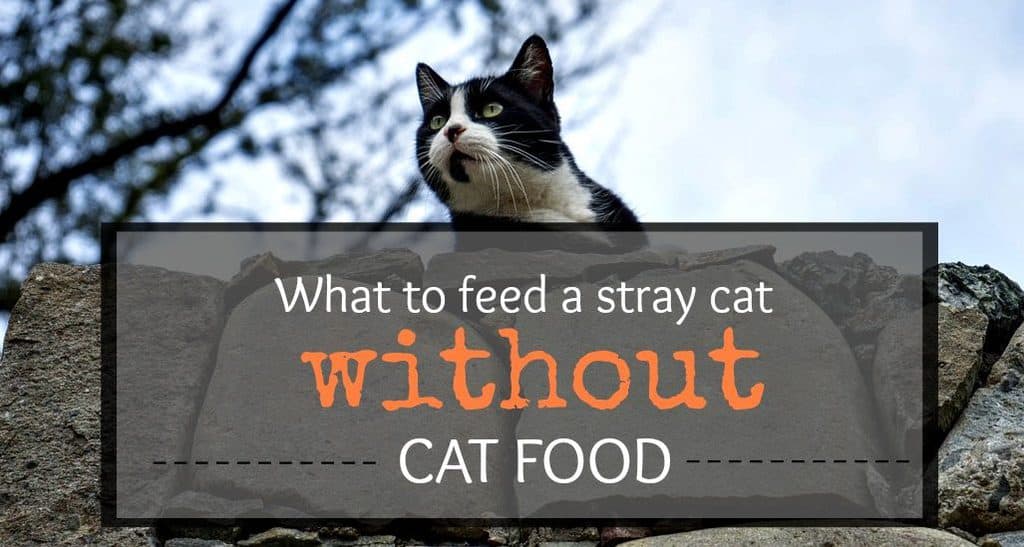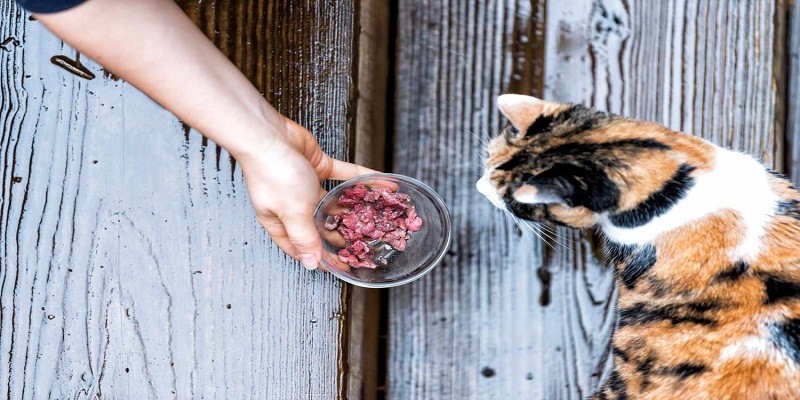Last Updated on January 14, 2025 by Pauline G. Carter
To feed stray cats, offer them wet or dry cat food and always provide fresh water. Stray cats are often found wandering around looking for food.
Providing food for them can be a humane and fulfilling experience. However, giving them the wrong food can be harmful and potentially fatal. Most cats thrive on a diet of wet or dry cat food, as it contains the nutrients and protein they need to stay healthy.
Never feed them food scraps or dog food, as these can cause digestive problems. When feeding strays, try to establish a consistent feeding schedule and keep track of the amount of food provided. Offering fresh water is also crucial, as dehydration can lead to serious health issues. With these simple steps, caring for stray cats can become a rewarding and compassionate act.

Credit: thefluffykitty.com
Understanding The Nutritional Needs Of Stray Cats
Caring for stray cats can be quite challenging, especially if you’re unsure of what their nutritional needs are. Proper nutrition is essential for every living creature, including stray cats, as it ensures their overall well-being and longevity.
Why Proper Nutrition Is Important For Stray Cats
- Promotes healthy weight and growth: Feeding stray cats the right food in proper portions helps to maintain a healthy weight and aids in their growth and development.
- Boosts immune system: The right combination of nutrients can help strengthen the immune system of stray cats, which helps fight off infections, diseases and keeps them healthy.
- Promotes healing: Adequate nutrition can help stray cats recover quickly from an injury or illness by providing the necessary nutrients needed for their body to heal.
- Increases lifespan: Proper nutrition increases the lifespan of stray cats by providing them with the necessary nutrients they need to thrive.
Determining The Nutritional Needs Of Stray Cats
Determining the nutritional needs of stray cats can be a bit tricky as they don’t have the luxury of consistent access to food. However, there are certain nutrients they need to stay healthy.
- Protein: Stray cats require protein in their diet as it helps build and repair tissues in their body.
- Fat: Stray cats also need fat to provide them with energy and to keep their skin and fur healthy.
- Carbohydrates: While not as essential as protein and fat, carbohydrates provide energy for stray cats.
- Vitamins and minerals: Stray cats need vitamins and minerals such as vitamin a, b, c and e, calcium, phosphorus, and iron for their overall well-being.
Ensuring stray cats receive proper nutrition is essential to their health and longevity, in much the same way that it is for humans. By understanding the nutritional needs of stray cats and providing them with the proper food, we can help ensure that they lead healthy, happy lives.
Types Of Food That Are Safe And Healthy For Stray Cats
Feeding stray cats can be a rewarding experience but with a range of pet food options, choosing what to feed them can be tricky. It’s crucial to remember that what you offer can affect the cat’s health, so it’s vital to feed them only the best suitable diet.
Here are different types of food that are safe and healthy for stray cats.
Wet Vs Dry Food: Which One Is Better For Stray Cats?
Wet and dry food both have different nutritional values and come with their own sets of advantages and disadvantages. Here are some points to consider:
- Wet food is more hydrating, which means it helps to keep cats hydrated.
- Dry food can be more cost-effective and convenient, as it does not require refrigeration.
- Wet food can help with dental hygiene, as it’s less likely to stick to teeth.
- Dry food has more calories, so it can be helpful if you’re feeding a cat with a high metabolism or those who are struggling to maintain a healthy weight.
It’s essential to remember that both types of food can be incorporated into stray cats’ diet, depending on their needs and preferences.
Homemade Cat Food: Is It Safe For Stray Cats?
Creating homemade cat food for strays is a noble idea, but also carries some risks. If not correctly prepared, homemade cat food can lack essential nutrients. Here are some essential points to consider:
- Consult with a veterinarian or animal nutritionist to ensure that the home-cooked diet meets the right nutritional balance.
- Homemade cat food can be time-consuming and may be more expensive than commercial pet food.
- Raw meat and potentially toxic ingredients should be avoided when preparing homemade cat food.
Commercial Cat Food: What To Look For When Choosing The Right Brand
Choosing the right commercial cat food for stray cats can be overwhelming, with so many brands available in the market. Here are some essential tips to consider:
- Check the label and ensure the cat food has a proper nutritional balance of protein, carbohydrates, and vitamins.
- Choose food specifically designed for strays or outdoor cats, as it comes with additional nutrients.
- Avoid food that contains artificial additives, preservatives, and low-quality ingredients like fillers or by-products.
By following these guidelines, you can select commercial cat food that will ensure stray cats remain healthy and full of energy.
Feeding stray cats is crucial, but it’s also necessary to maintain a proper balance of nutrients. By following the suggestions above, you can help ensure that the stray cats in your area receive the best diet they need.
Feeding Stray Cats: Tips And Best Practices
Stray cats are common nuisances in most towns and cities. People love to feed them, but the question arises, what’s the right food for them? As cold-hearted as it may sound, feeding stray cats without determining the nutritional value can actually harm them in the long run.
That’s why we’ve come up with some tips and best practices to make sure that you are doing no harm.
How Often To Feed Stray Cats
Stray cats do not have scheduled mealtimes. They are mostly forced to forage for food and often have to go through long hours without any meal. However, when it comes to feeding stray cats, it is essential to be consistent with timings.
Here are some tips on how often to feed stray cats:
- Feed stray cats at least once a day. Twice a day is ideal, but it may attract more wandering cats.
- Feed them at a fixed time, preferably during daylight hours.
- Do not overfeed them. Determine the amount of food they can finish in one sitting and do not leave excess food lying around.
Feeding Stray Cats Without Encouraging Dependency
Providing an accommodating environment can often encourage stray cats to keep hanging around your property, leading them to become dependent on your aid. If that happens, it’s best to encourage the cats to roam and forage.
- Provide food away from your property’s boundaries to avoid encroachment.
- Place the food in a designated spot, and do not offer them an alternative food source if they do not come to the designated spot.
- Provide the cats with fresh water and sterilized utensils.
Health Considerations For Feeding Stray Cats
Feeding stray cats is not just about filling their tummies. It’s also about keeping them healthy. Here are some considerations for feeding stray cats for better health:
- Stick to high-quality cat food that provides balanced nutrition.
- Do not feed them human food, dairy products, or processed foods.
- Avoid foods that can cause any allergic reactions.
- Check for signs of illness or injuries before feeding them.
- If you notice any abnormalities, seek professional help immediately.
Feeding stray cats is more than just leaving scraps of human food near your doorstep. It requires consistent timings, a designated feeding spot, and a cautious approach towards their health. Stray cats deserve the same level of care and attention as domestic cats, and by following these tips and best practices, you’ll be able to provide them with a better quality of life.
Frequently Asked Questions For What To Feed Stray Cats?
What Are The Best Food Options For Stray Cats?
Stray cats require protein-rich foods like dry kibble or canned wet food specifically made for cats.
Can Stray Cats Eat Human Food?
Some human foods like unseasoned cooked meat, fish, eggs, and cooked vegetables are safe for cats.
How Much Should I Feed A Stray Cat?
Feed stray cats small meals twice a day, consisting of a quarter cup of food per meal.
Should I Leave Food Out All Day For Stray Cats?
Don’t leave food out all day for stray cats as it may attract other animals and pests.
How Can I Make Sure A Stray Cat Is Eating Safely?
Place food in a sheltered area where cats can eat safely and away from other animals.
Conclusion
After all is said and done, feeding stray cats is not only a kind act of compassion, but it’s also our responsibility as humans to take care of these animals. Whether you choose to provide them with commercial pet food or homemade meals, ensure that the food is well-balanced, and it accommodates their nutritional requirements regarding their age and health status.
Remember always to have fresh water available to avoid dehydration. Stray cats may have distinctive needs, but that does not mean you cannot make a significant impact in their lives. As much as you feed them, try to keep them healthy by providing them with shelter, veterinary care, and constant sanitation.
By doing this, you not only reduce the risks of diseases and infections but also create a better and safer environment for everybody. Finally, stray cats deserve to be treated with love, kindness and utmost respect.

